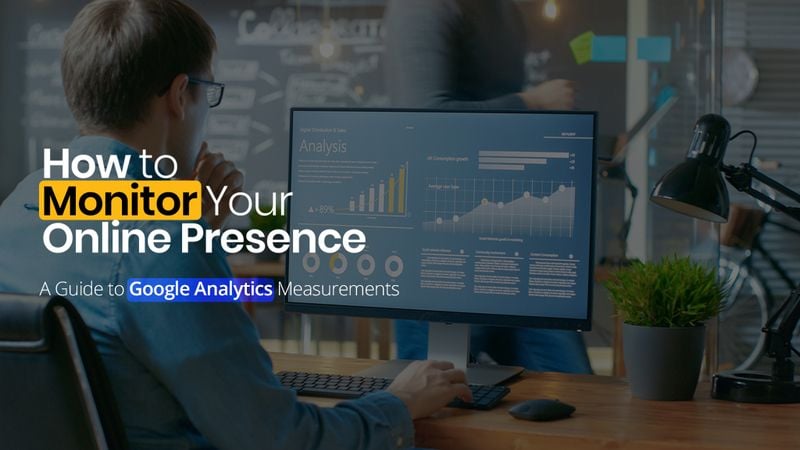How to Monitor Your Online Presence: A Guide to Google Analytics Measurements
)
So, you're at that point in your internet journey where you've got your website and marketing campaigns up and running - Google Analytics also in place, measuring all the important details you need to know. But what if you don't really understand what these metrics mean? Having data is one thing; being able to understand what it means for you is another. What if your data says you have a 54% bounce rate? 54% is good, right? It's more than half. But what's a bounce rate? In this context, what does 54% say about your site? Are you meeting your goals?
This is why it's really important to understand the meaning behind the metric, in order to know if your data is indicating something good or bad, and how you can evaluate your next steps accordingly. Luckily, we've brought to you all the things you need to know about your metrics; next time you're asking "what does this even mean?" - you know where to come!
The Bloomtools Google Analytics Guide: Volume 1
Sessions
Basically, sessions refers to the number of times a user has stayed on your website for a specific amount of time. Sessions are recorded in two ways: time and "campaigns". For instance, if a visitor leaves your site and returns - this is still classified as the same session. If a user is inactive for more than half an hour before they return - this is then considered a new session. A campaign session ends when a user enters your site via a particular channel and then leaves and returns via another channel - when the user re-enters via the different channel, this will start a new session. The important aspect of analysing this metric is looking at the influx of individual sessions - as you can gather from the above information, it's easy for one user to have multiple sessions, so take a look at how many individual users you have contributing to these sessions.
% New Sessions
This refers to how many new users are visiting your site - it indicates how well your marketing efforts are performing in regards to driving new traffic to your site. This is great for measuring whether your users consider your site worthy of visiting multiple times. It's important to keep a good balance of new and returning users, however, if your current marketing goal is to generate new leads, then this is a great metric to gather some insight.
New Sessions
This one is great for measuring how much new traffic is coming to your site - it reports the number of first-time visitors from users who've never visited before. If this percentage is low, it could reflect that most of your visitors are returning visitors - in saying that, it's important to keep a good ratio of new and returning users.
Channels
In basic terms, channels reflect how a user got to you; what path did they take to find your website. There's several ways your website can be found. It could involve organic search (perhaps the most important search, it means you were found from keywords that bought you up in the search engine - it reflects the strength of your SEO overall), referral traffic (if someone comes to you from another site via a link), social traffic (the user came from a social media platform link) or direct traffic (your websites URL was type directly into a search bar).
Traffic
An important metric that indicates site reach and growth - it reflects the number of visits (sessions) that occur on your site. Another metric to use to scope how well your marketing efforts are going.
Entrances
An entrance occurs when a visitor comes to your site and begins a new session. How are these different from visits? Well, only one entrance can occur in a session, while multiple visits can occur during a session.
Page Views
This one is pretty self-explanatory - it refers to a view of your page on your site by a visitor. It reflects how often your website content is accessed by a user.
Bounces
A bounce refers to a single-page session on your website, meaning a user opened a single page on your site and then exited without doing anything else. A high bounce rate is not ideal if you have multiple pages.
Bounce Rate
This metric reflects the level of user engagement and the quality of your content. Additionally, it helps to identify any issues that might exist on your site. However, this metric is kind of unreliable on it's own - it should be analysed alongside average session duration and pages per visit to give a better insight. There's multiple influences to a high bounce rate - it could be poor quality content, unpleasant aesthetics or even poor ease of use/navigation of your site. If your bounce rate is really high, it could be a sign that users are leaving your site without exploring.It can be used to uncover any issues and how you can resolve them to make your site more interesting.
Pages Per Session
From this metric, we see the average number of pages a visitor goes to during a single session. The more pages per session, the more a user is engaging with your site and exploring more of it. In this circumstance, the closer the pages are to how many it would take to seal a conversion, the better!
Average Session Duration
From this metric, we see the average number of pages a visitor goes to during a single session. The more pages per session, the more a user is engaging with your site and exploring more of it. In this circumstance, the closer the pages are to how many it would take to seal a conversion, the better!From this metric, we see the average number of pages a visitor goes to during a single session. The more pages per session, the more a user is engaging with your site and exploring more of it. In this circumstance, the closer the pages are to how many it would take to seal a conversion, the better!
Exit Rate
Not to be confused with bounces, the exit rate refers to the percentage of visitors that come to your page and leave - the exit rate is associated with a page, NOT your website. This is a great way of gauging which of your pages could use a content update to ensure it's engaging enough to keep your users interacting with important information.
Goal Conversion Rate
Perhaps one of the most important metrics, the goal conversion rate refers to the percentage of visits that resulted in a conversion relevant to your goal. This metric is a great way, and perhaps the key indicator, of knowing how effective your website is. A high conversion rate indicates you're on the way to reaching your objectives, a low one means users aren't engaging with your website enough to get you conversions.
Goal Completions
This refers to how well your goals are impacting your business. The goals you set are what you consider as an important conversion; this could be a form being filled out or even a brochure being downloaded - not just purchase based conversions. You can set these goals up yourself, assigning them to any part of your website that can be measured (like the previously mentioned brochure downloads for example).
Goal Value
Referring to the monetary value of your goal conversions, the goal value reflects the worth of each conversion to your business. When setting goals, you can set monetary values to these goals.
What you can learn from all these metrics is that not one singular metric alone is a key indicator of success, rather a combination of them is required to get a clearer picture about what's taking place with your website. When you consider the bigger picture of what a combination of your metrics are saying, you can figure out where you're performing best or where you can improve.
Do you want to maximise your marketing campaigns this year, but want some extra help with any of the above techniques? Feel free to reach out to your internet marketing specialists here for more information. Book a consultation with us today!
| Tags:Internet MarketingLead Generation |
Check Out Our
Recent Articles
- 2025 Top Australian Business Directories to Boost Your Visibility
- The Power of Online Reviews: What the Latest Data Means for Your Business
- Why Blog Length Matters: Striking the Perfect Balance for Your Content
- Top Marketing Strategies for 2025
- Winning Strategies to Get More Reviews on Google, Facebook, and Beyond



